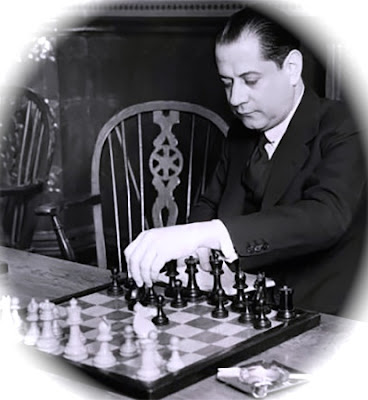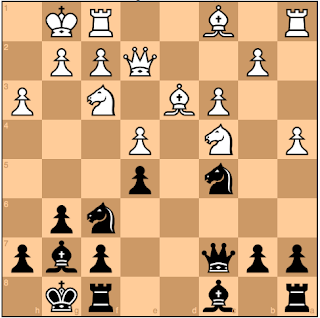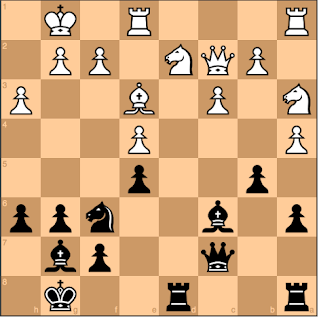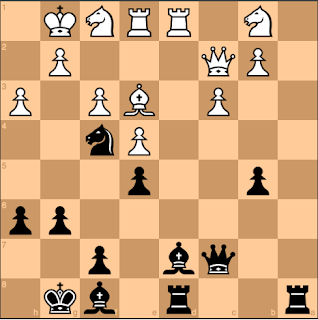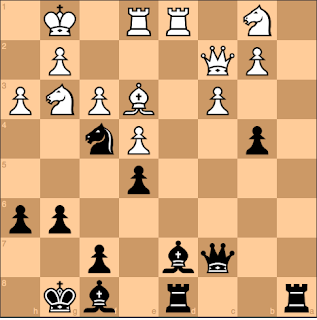Isabella Lai vs Bernardo Iglesias
Cambridge, MA (BCC Polar Vortex, U1800 Section, R=3) 2018
CRITICAL POSITION
[BACKSTORY: I had already finished my game
scoring a total of 2.5/3. So I felt good that I
would win some money. How much? Well
If Isabella won her game with Bernardo, She
too would have scored 2.5 points and we would
have tied for 1-2nd place. If Isabella drew or
Bernardo won, I would have clear 1st place.
That is what prompted me to take a photo of
the position, with Bernardo to move, which
is provided above. Ooh! I thought, it looks like
Isabella might be able to pull a rabbit out of
the proverbial hat. Could she find the moves
to draw this game(?), or if Bernardo played
inaccurately, could Isabella actually win(?)!
This is the question facing all of us now, as
we look at the above position. Well I think
I have a resolution to my "issue" provided by
Suraj Ramanathan. Two "winning" lines are
provided below. What do you think?
Give us feedback on the BCC Blog!]
The best try is this: After Black's best move:
1. . . . Rd7; White should play:
2.e6 Re7; 3.Nf7+ Kg7; 4.Nxh8 Kxh8;
5.d5 Kg7; 6.Rf4 Nd6; 7.Kf1 Rc7; 8.Ke2 Rc5;
9.Rd4 Kf6; 10.Kf3 Nf5; 11.Rd1 Nxh4+;
12.Kg3 Nf5+ 13.Kf4 Nd6; 14.Kf3 Ke7;
15.Kf4 Rc8; 16.Ke5 Rf8
[STUDY THIS DIAGRAM]
THE QUESTION IS:
CAN WHITE HOLD
(MEANS DRAW)?
and the computer
(Houdini 4 Pro x 64B: 3408 Elo rating) gives
an evaluation of -1.68 which I would depict,
in the old style as -/+: good but not necessarily
winning, for Black, provided Isabella did
not mess up playing this position, or of course,
provided Bernardo did not make a serious
mistake from which he could not extricate
himself. Well, we shall never know but!!
I suggest taking the position resulting
from the move 2.e6 above and try to continue
to explore winning moves for Black or
drawing for White.)
Another way to play the position would be:
Instead of 2.e6, the rather dubious 2.d5?!:
So we have 1. . . . Rd7; 2.d5 Rxd5; 3.Nf7+ Kg7;
4.Nxh8 Rd1+ 5.Kh2 Rd3! 6.Rf7 Kxh8;
7.Rf8+ Kg7; 8.Rxe8 Rxc3 - + (Black's king
is better placed and his c-pawn will promote).
The best try is this: After Black's best move:
1. . . . Rd7; White should play:
2.e6 Re7; 3.Nf7+ Kg7; 4.Nxh8 Kxh8;
5.d5 Kg7; 6.Rf4 Nd6; 7.Kf1 Rc7; 8.Ke2 Rc5;
9.Rd4 Kf6; 10.Kf3 Nf5; 11.Rd1 Nxh4+;
12.Kg3 Nf5+ 13.Kf4 Nd6; 14.Kf3 Ke7;
15.Kf4 Rc8; 16.Ke5 Rf8
[STUDY THIS DIAGRAM]
THE QUESTION IS:
CAN WHITE HOLD
(MEANS DRAW)?
and the computer
(Houdini 4 Pro x 64B: 3408 Elo rating) gives
an evaluation of -1.68 which I would depict,
in the old style as -/+: good but not necessarily
winning, for Black, provided Isabella did
not mess up playing this position, or of course,
provided Bernardo did not make a serious
mistake from which he could not extricate
himself. Well, we shall never know but!!
I suggest taking the position resulting
from the move 2.e6 above and try to continue
to explore winning moves for Black or
drawing for White.)
Another way to play the position would be:
Instead of 2.e6, the rather dubious 2.d5?!:
So we have 1. . . . Rd7; 2.d5 Rxd5; 3.Nf7+ Kg7;
4.Nxh8 Rd1+ 5.Kh2 Rd3! 6.Rf7 Kxh8;
7.Rf8+ Kg7; 8.Rxe8 Rxc3 - + (Black's king
is better placed and his c-pawn will promote).
PHOTO: STEVE STEPAK



















